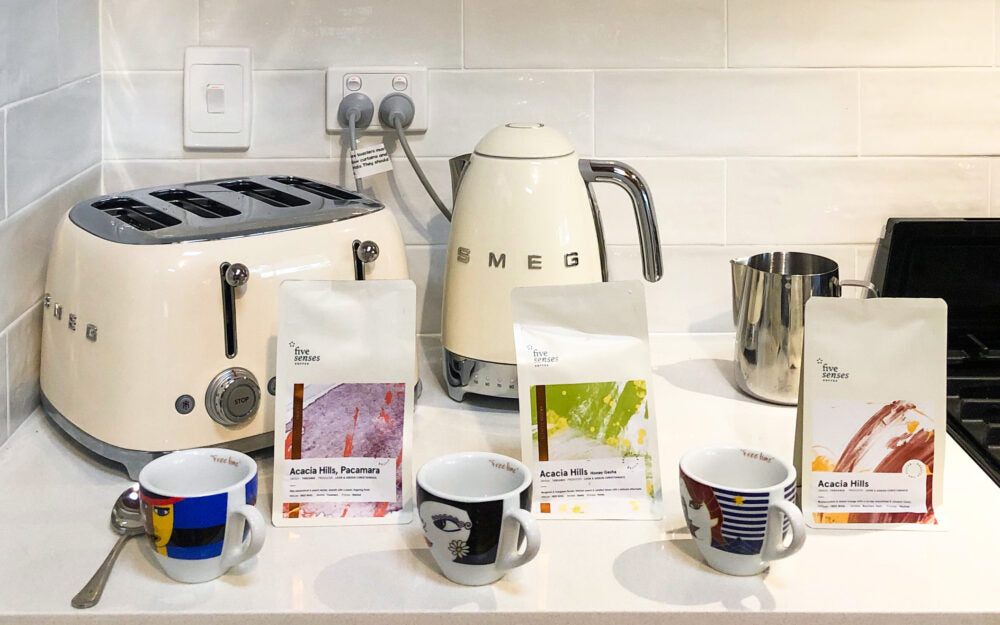Cupping is the practice that Five Senses, along with most coffee folks around the world, use to professionally evaluate and compare coffee samples. There’s a standardised protocol developed by the Specialty Coffee Association which keeps us comparing apples with apples – no matter if we’re cupping in Perth or in Panama.
Cupping might seem a little complicated but the setup, once you’ve got the method right, is pretty simple. Dive deep the official protocals here or keep reading for home cupping 101!
What you need for Cupping
- Coffee! We recommend cupping at least 3 different coffees at a time – a side by side comparison helps detect differences in flavour, acidity, body and aftertaste.
- Heat proof cups/bowls – preferably of even volume. You need at least 1 cup/bowl for each coffee.
- Scales
- Cupping Spoons – or plain ol’ soup spoons! You need at least 2 spoons for clearing the top of the bowls. Make sure everyone has they’re own spoon to slurp with.
- Rinse water. Put hot water in a small bowl for rinsing spoons in.
- Kettle
- Timer
- Things to take notes with. Optional but recommended. Keeping track of multiple coffees can get confusing! We’ve made a simple sheet here if the full SCA sheet is a little daunting.
- Grinder. Optional but recommended. If your coffee is pre-ground, you won’t need a grinder.
- Filtered water. Optional but recommended.
- Spittoon. Optional – depends on your desired caffeine intake.

Setting up the Cupping
- Work out how much liquid your cupping bowls hold; set them on the scales, tare off and pour water right to the rim. The weight is your liquid volume.
- Weigh your doses for each of the three coffees. The cupping water to coffee ration is 0.055g / ml of water. So, for example, if you cupping bowl held 200ml of water, you’d want 11g of coffee (200 x 0.055).
- You want to grind these doses into your cupping bowls no more than 15 minutes prior to cupping. The grind size should be a little coarser than pourover. The ‘coarse’ grind HERE is a good reference. Pop the freshly ground coffee into the bowls and cover to retain the fragrance.
- Fill your kettle with filtered water and set to boil. If your kettle can hold at a specific temp, aim for 95°C. If using a good ol’ manual version, you’ll want to leave your kettle to cool for 1 minute post boil before pouring.

How to Cup Coffee at Home
Don’t sweat; in this guide we’re not going to be formally scoring these coffees as that’s a lot more complex (see: The Q Grader Gauntlet). Learning the basics and tasting is the focus! We’ve put together a simple sheet here to help with the process, and for taking notes down – feel free to print it off and fill it in while cupping. Ideally you don’t discuss what you’re smelling / tasting with other cuppers until everyone is done – this stops people being influenced mid-cupping.
- Evaluate fragrance of the dry grinds.
- Start your timer and pour your hot water, making sure to wet all grinds and fill to the rim.
- You should see a layer of grinds, or crust form on top. Leave for 4 minutes.
- Fill your rinse bowl with hot water.
- Gently break crust by pushing grinds front to back of the bowl. They should sink and lots of tasty aromas released from beneath – get down close and inhale these as you break the crust.
- In between each crust break, dip / clean your spoon in the rinse bowl.
- Use the two spoons to skim off the last grinds from the top of the bowl. Dump the skimmed grinds into a waste bowl.
- Leave to cool for ~ 10minutes.
- To cup, take a small volume of coffee and slurp it off your spoon, like you would a hot soup. This’ll vaporise the liquid, making it easier to detect flavour.
- Repeat this for each of the coffees, using the side by side comparison to help detect differences in flavour, acidity, body and aftertaste.
- Note down any flavours you taste, and anything else you might have noticed about the body and aftertaste.
- Optional: share your tastes with the rest of the cuppers! Did anyone else taste similar things to you? If so, congrats, sounds like you’re calibrated!
- Cupping success!
Resources
Coffee Cupping Basics sheet



